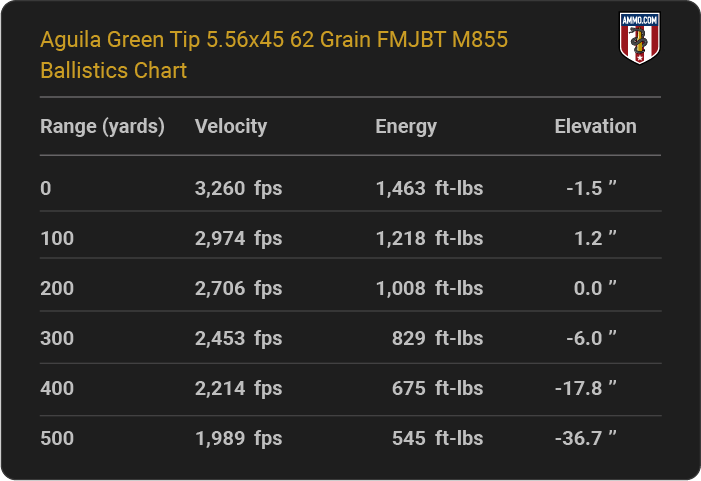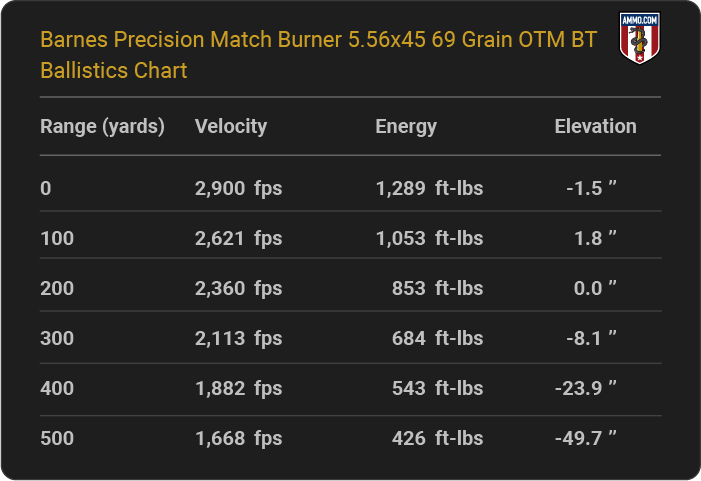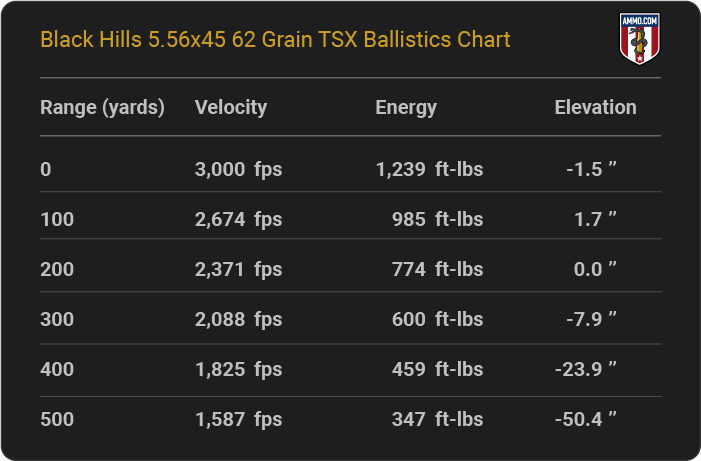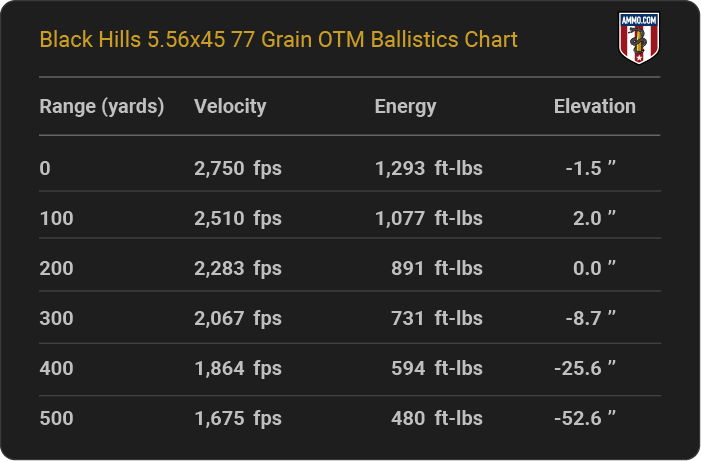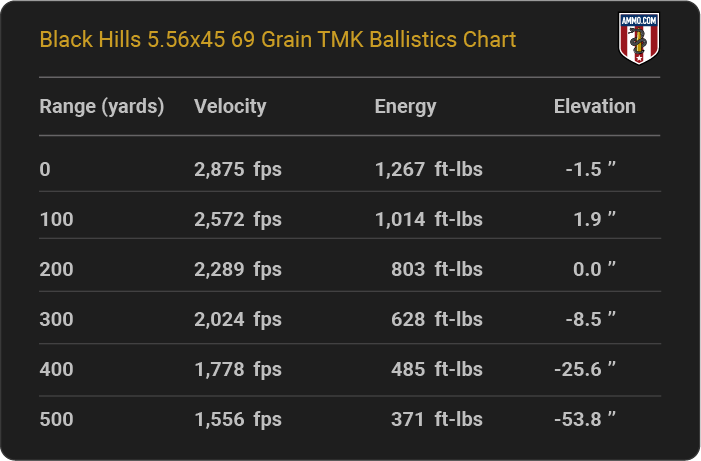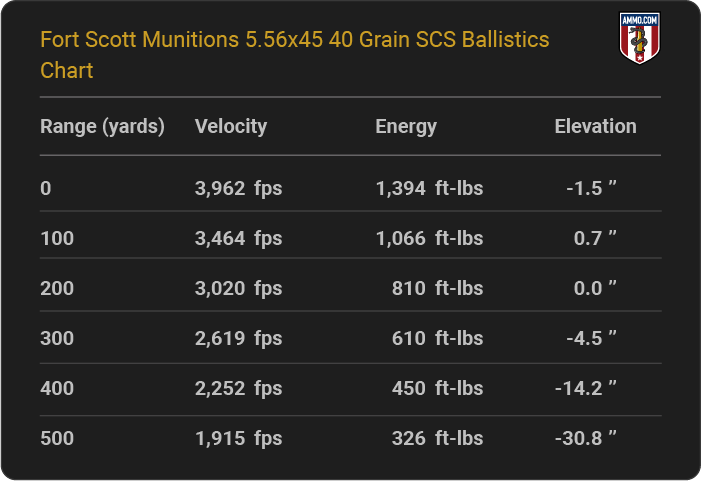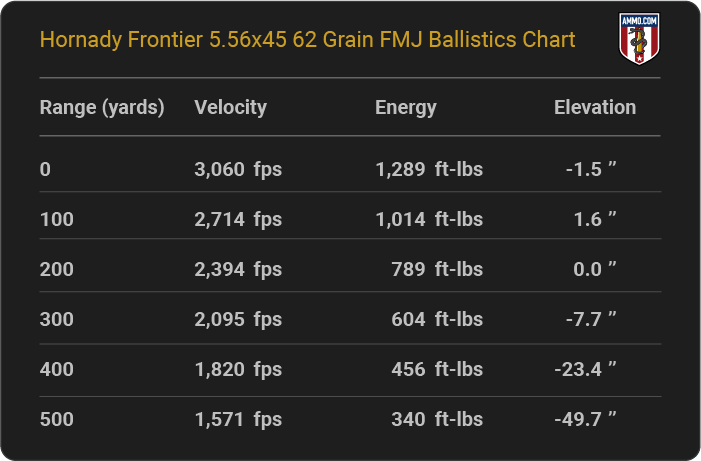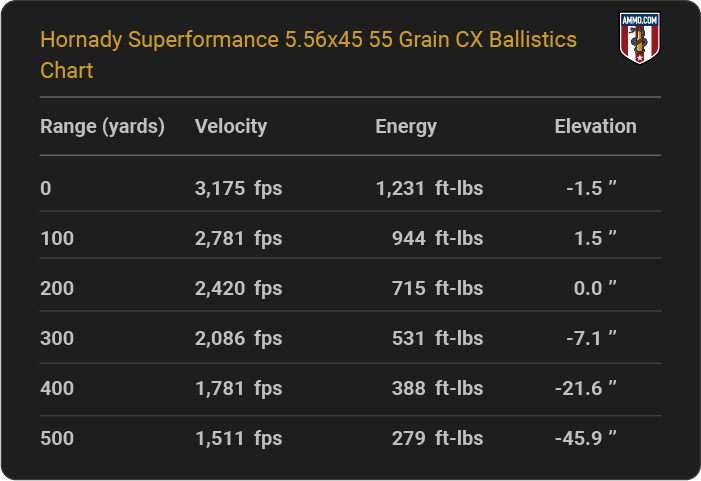Congrats! You’ve found our in-depth look at 5.56 ballistics from numerous ammo manufacturers.
Aguila Ammunition Ballistics - 5.56 NATO
Aguila 5.56x45 55 grain Ballistics Chart
Aguila 5.56x45 62 grain FMJBT Ballistics Chart
Aguila Green Tip 5.56x45 62 grain FMJBT M855 Ballistics Chart
Barnes Ammunition Ballistics - 5.56 NATO
Barnes Precision Match Burner 5.56x45 69 grain OTM BT Ballistics Chart
Barnes Precision Match Burner 5.56x45 85 grain OTM BT Ballistics Chart
Barnes VOR-TX 5.56x45 62 grain TSX BT Ballistics Chart
Barnes VOR-TX 5.56x45 70 grain TSX BT Ballistics Chart
Black Hills Ammunition Ammunition Ballistics - 5.56 NATO
Black Hills 5.56x45 50 grain TSX Ballistics Chart
Black Hills 5.56x45 62 grain TSX Ballistics Chart
Black Hills 5.56x45 69 grain OTM Ballistics Chart
Black Hills 5.56x45 77 grain OTM Ballistics Chart
Black Hills 5.56x45 69 grain TMK Ballistics Chart
Black Hills 5.56x45 77 grain TMK Ballistics Chart
Black Hills 5.56x45 70 grain GMX Ballistics Chart
Black Hills Dual Performance 5.56x45 62 grain Ballistics Chart
Fort Scott Munitions Ammunition Ballistics - 5.56 NATO
Fort Scott Munitions 5.56x45 40 grain SCS Ballistics Chart
Fort Scott Munitions 5.56x45 55 grain SCS Ballistics Chart
Fort Scott Munitions 5.56x45 62 grain SCS Ballistics Chart
Fort Scott Munitions 5.56x45 70 grain SCS Ballistics Chart
Hornady Ammunition Ballistics - 5.56 NATO
Hornady Black 5.56x45 62 grain FMJ Ballistics Chart
Hornady Black 5.56x45 75 grain Interlock HD SBR (11.5" Barrel) Ballistics Chart
Hornady Frontier 5.56x45 55 grain FMJ Ballistics Chart
Hornady Frontier 5.56x45 62 grain FMJ Ballistics Chart
Hornady Frontier 5.56x45 55 grain HP Match Ballistics Chart
Hornady Frontier 5.56x45 68 grain BTHP Match Ballistics Chart
Hornady Frontier 5.56x45 75 grain BTHP Match Ballistics Chart
Hornady Superformance 5.56x45 55 grain CX Ballistics Chart
Hornady Superformance Match 5.56x45 75 grain BTHP Ballistics Chart
PMC Ammunition Ballistics - 5.56 NATO
PMC 5.56x45 55 grain FMJBT Ballistics Chart
PMC Green Tip 5.56x45 62 grain LAP Ballistics Chart
Prvi Partizan (PPU) Ammunition Ballistics - 5.56 NATO
Prvi Partizan Rangemaster 5.56x45 55 grain FMJBT Ballistics Chart
Sig Sauer Ammunition Ballistics - 5.56 NATO
Sig Sauer Marksman Elite 5.56x45 77 grain OTM Ballistics Chart
Winchester Ammunition Ballistics - 5.56 NATO
Winchester Defender 5.56x45 64 grain JHP Ballistics Chart
Winchester Match 5.56x45 77 grain BTHP Match Ballistics Chart
Winchester Target 5.56x45 55 grain FMJ Ballistics Chart
Winchester Target & Practice 5.56x45 55 grain FMJ M193 Ballistics Chart
Winchester Target & Practice 5.56x45 62 grain FMJ M855 Ballistics Chart
Wolf Ammunition Ballistics - 5.56 NATO
Wolf Performance Gold 5.56x45 55 grain FMJ M193 Ballistics Chart
Administrative Note: The information above comes from the manufacturers. The actual ballistics obtained with your firearm can vary considerably from the advertised ballistics. Also, ballistics can vary from lot to lot with the same brand and type load. When manufacturer ballistic data were unavailable, ballistics were calculated using a ballistics calculator.
5.56 Trajectory Chart
A bullet’s flight path is its trajectory. Shooters often measure the bullet’s elevation in inches of bullet drop, but it’s also measured in minutes of angle (MOA).
A flat trajectory is preferred because it allows the shooter to make fewer adjustments to compensate for bullet drop. The 6.5 Creedmoor is an excellent example of a flat-trajectory cartridge, which is why it’s so popular among long-range shooting enthusiasts.
While the 5.56 NATO is not the typical long-range caliber, it has a relatively flat trajectory out to 500 yards thanks to its lightweight projectiles and relatively high ballistic coefficients. Depending on the load you’re firing, you can expect a 55 grain FMJ to drop about 47” at 500 yards when zeroed in at 200 yards. A 77 grain hollow point boat tail will drop about 53” at 500 yards when sighted in at 200 yards.
Below is a sample 5.56 bullet drop chart that provides a general idea of the 5.56 NATO trajectory with a sight height of 1.5”.
Note: The chart above is an example of one 5.56 load. Actual ballistic performance may vary depending on bullet weight, lot, barrel length, and environmental conditions while shooting.
5.56 Velocity
A bullet’s muzzle velocity is the rate at which it exits the rifle barrel, measured in feet per second (fps).
Generally, a longer barrel produces a higher muzzle velocity, as it gives the exploding propellant more time to exert its energy against the projectile’s base. Bullet design and weight also bear significantly on how much velocity a projectile will exhibit downrange.
For example, heavier bullets have higher inertia, and tend to have relatively lower muzzle velocities as a result. Polymer-tipped hollow point boat tail bullets, on the other hand, tend to conserve velocity more efficiently than traditional soft point bullets because they’re more ballistically efficient.
Handloads also tend to have higher velocities than factory-loaded ammo, which is one reason why reloading is so popular among dedicated shooting enthusiasts and competitive shooters.
The muzzle velocity of factory 5.56 ammo ranges from 2,700 fps to 3,300 fps, depending on the exact load and whether you’re firing a 5.56 handgun, carbine or rifle.
5.56 Kinetic Energy
A bullet’s energy is measured in foot-pounds (ft-lbs). Muzzle energy reflects the force with which a projectile exits the barrel. Heavier bullets tend to have higher muzzle energy. Velocity is also significant, which is why lighter bullets can have greater muzzle energy than heavier bullets.
A higher muzzle energy typically means the round has more recoil. The 5.56 NATO’s lightweight bullets generate relatively little recoil energy, which makes it an excellent cartridge to introduce someone to shooting.
The biggest problem with lightweight projectiles is that they conserve relatively less energy downrange. For instance, a 50 grain TSX with a muzzle energy of 1,191 ft-lbs will only conserve 184 ft-lbs at 500 yards, whereas a 77 grain open tip match with a muzzle energy of 1,293 ft-lbs will conserve 480 ft-lbs at the same distance. This is why shot placement becomes even more critical when it comes to lightweight projectiles.
5.56 Effective Range
The 5.56’s great versatility has made it wildly popular among American shooters. It’s commonly used for target shooting, varmint and predator hunting, boar hunting, personal protection and home defense.
When chambered in a rifle with a 20” barrel, the 5.56 NATO has a maximum range of about 1,000 yards for target shooting. Naturally, success hinges on the shooter’s skill level, the quality of their ammo, and environmental conditions.
The effective range of 5.56 rounds for hunting drops to about 600 yards. The lightweight projectiles don’t maintain enough energy to harvest game animals ethically over long distances.
How Do 5.56 Ballistics Compare to Other Rifle Cartridges?
The 5.56 NATO is one of the most popular rifle cartridges on the planet, and its versatility means it can be compared to countless other cartridges. The most common is the 223 Rem, as it is virtually identical (with the caveat that a 5.56 round cannot safely chamber in a 223 Rem rifle). Even so, other rifle cartridges might prove a better option depending on the circumstances.
Let’s check them out below!
5.56 vs. 223 Remington Ballistics Chart
5.56 vs. 6.8 SPC Ballistics Chart
Don’t miss our in-depth look into 6.8 SPC ballistics for more information.
5.56 vs. 6.5 Grendel Ballistics Chart
5.56 vs. 7.62x39 Ballistics Chart
Don’t miss our in-depth look into 7.62x39 ballistics for more information.
Frequently Asked Questions
The team at Ammo.com has gathered and answered some of the most commonly asked questions regarding 5.56 ballistics.
How much does a 5.56 drop at 300 yards?
A 5.56 will drop 8-9 inches at 300 yards when sighted in at 200 yards, depending on the load you’re firing.
What is the maximum effective range of a 5.56?
The maximum effective range of a 556 is 1,000 yards for target shooting and 600 yards for hunting.
What is the lethal velocity of 5.56 ammo?
The lethal velocity of 5.56 ammo is about 600 fps.


